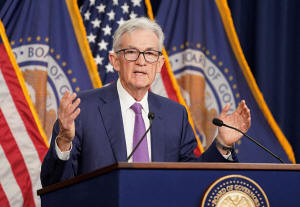Fed's communications style scores well with analysts but not public
 Send a link to a friend
Send a link to a friend
 [May 09, 2024] By
Howard Schneider [May 09, 2024] By
Howard Schneider
WASHINGTON (Reuters) - Through a tumultuous period of high inflation,
aggressive interest rate hikes, and global instability, the U.S. Federal
Reserve received relatively high marks for its monetary policy
communications despite the thicket of uncertainty it has been
navigating, according to a survey of academic and private-sector
analysts released on Thursday.
Responses from 31 academic and 24 private Fed watchers to questions
posed by the Brookings Institution's Hutchins Center on Fiscal and
Monetary Policy gave the U.S. central bank under Fed Chair Jerome Powell
a median score of B+ for its overall communications, an important aspect
of central bank operations that can make monetary policy itself more or
less effective.
The score was slightly lower than the median of A- the Powell-led Fed
received in a 2020 survey conducted as the central bank rolled out a
complicated series of programs in response to the COVID-19 pandemic.
But it still showed the Fed's core communications tools, in particular
the press conference that Powell holds after each policy meeting,
playing an "extremely useful or useful" role in explaining the central
bank's decisions and outlook.

More than 80% of respondents regarded Powell's press conference that
way, and more than 70% said the same about the quarterly economic
outlook that assembles the views of policymakers about inflation,
unemployment and economic growth, and the Fed's policy statement itself.
The "dot plot" of policymakers' rate projections got a more mixed
review, as it was seen as extremely useful or useful by only about half
the respondents, reflecting ongoing debate about whether that particular
bit of Fed communication is more confusing than clarifying.
Speeches by other members of the Fed's Board of Governors, the Fed's 12
regional bank presidents, and media coverage were seen as even less
compelling, with more than 60% of respondents regarding them as only
somewhat useful or not useful at all.
The survey was conducted between March 22 and April 5, as the Fed was in
the midst of what turned into a resetting of expectations away from an
outlook of imminent rate cuts to one of more sustained tighter monetary
policy.
The switch was just the latest communications challenge Powell has
faced, and he has not come off well across the board.
Views of Fed communications slipped in a New York Fed survey of Wall
Street primary dealers conducted in January, though the Powell-led Fed
has scored better among that group on average than when his
predecessors, Janet Yellen and Ben Bernanke, headed the central bank.
An annual Gallup poll of U.S. economic stewardship released this week
also showed continued low public confidence ratings for Powell, with
just 39% of respondents saying they had a "great deal or a fair amount
of confidence" in him to "do or to recommend the right thing for the
economy."
[to top of second column] |

U.S. Federal Reserve Chair Jerome Powell holds a press conference
following a two-day meeting of the Federal Open Market Committee in
Washington, U.S., May 1, 2024. REUTERS/Kevin Lamarque/File Photo

His latest mark was slightly higher than the 36% he got last year, a
low point among Fed chiefs and a sharp decline from the nearly 60%
confidence rating Powell received during the thick of the COVID-19
response when the Fed was back-stopping the economy in unprecedented
ways. It also showed a deep partisan divide, with 56% of Democrats
and just 30% of Republicans voicing confidence in Powell, a veteran
of past Republican administrations who has nevertheless won Fed
appointments from presidents in both parties.
WEIGHT OF POWELL'S WORDS
Fed officials regard their communications as a separate instrument
of policy. The central bank issues closely edited statements after
each policy meeting where the addition or deletion of an adjective
can rock financial markets, and releases assorted other documents
including meeting minutes and anecdotal economic reviews in between
those meetings. Fed officials also give a plethora of interviews and
public speeches - perhaps too many.
Nearly 60% of respondents felt the Fed regional bank presidents
should talk less, while 88% said Powell should speak the same amount
or more, evidence of the continued primacy of his words despite the
premium he has put on consensus.
The Brookings survey included topics beyond Fed communications, and
notably found a strong two-thirds majority of respondents opposed
raising the current 2% inflation target, a policy option Fed
officials have roundly rejected at least for the time being.
Regarding the Fed's current approach to monetary policy, which was
overhauled in 2020 and is due for review soon, there was general
support for retaining its emphasis on maximum employment.
There was less support for keeping an approach to managing inflation
which aims to use periods of above-target inflation to make up for
times when inflation is weak - a strategy that made sense when it
was adopted, after a decade of tepid price increases, but which
seemed dated after the eruption of inflation to a 40-year high in
2022.

About 60% of respondents said the Fed should "substantially revise"
or at least "tweak" that part of its operating framework.
(Reporting by Howard Schneider; Additional reporting by Ann Saphir;
Editing by Paul Simao)
[© 2024 Thomson Reuters. All rights
reserved.]
This material may not be published,
broadcast, rewritten or redistributed.
Thompson Reuters is solely responsible for this content. |